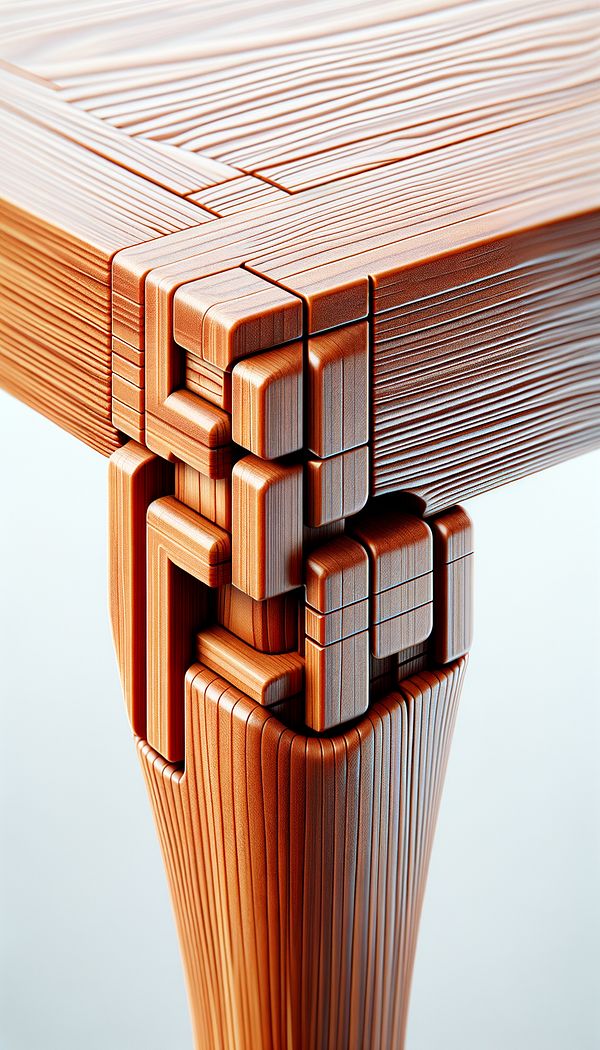What is Mortise & Tenon?
Mortise & Tenon is a type of joinery that involves fitting a projection (tenon) into a corresponding cavity (mortise) to create a stable, interlocking connection.
Description
Mortise & Tenon joinery is one of the oldest and most revered methods of joining two pieces of wood in the world of woodworking and furniture construction. This technique creates an extremely strong and durable connection because the tenon, shaped from the end of one piece of wood, fits snugly into a mortise, a hole or recess carved into the second piece of wood. When properly crafted and fitted, this interlocking joinery method provides a tight and sturdy connection without the need for nails or screws, which can enhance both the aesthetic and structural integrity of a piece of furniture.
The effectiveness of a Mortise & Tenon joint depends on precise craftsmanship, with each component cut to exact specifications to ensure a perfect fit. Traditionally, these joints have been cut and shaped by hand, though modern advancements have introduced machinery that can perform these tasks with greater speed and accuracy. Nevertheless, handcrafted Mortise & Tenon joints are highly valued for their craftsmanship and durability, and are commonly found in high-quality furniture and architectural elements such as door frames, window frames, and paneling.
Depending on the specific application or design preference, several variations of Mortise & Tenon joinery exist, including the through tenon, the stub tenon, and the wedged tenon, among others. Each offers a different aesthetic and level of structural support, making Mortise & Tenon joinery a versatile tool in the interior designer’s toolkit.
Usage
In the realm of interior design and furniture making, Mortise & Tenon joinery is often utilized in the construction of wooden tables, chairs, bed frames, and cabinetry. Given its strength and stability, this joinery method is preferred for pieces that require durability and longevity. Additionally, because Mortise & Tenon joints can be crafted to be nearly invisible or prominently featured for their aesthetic appeal, they offer designers versatility in integrating structural elements into the overall design of a piece. For example, a designer might choose a through tenon, where the tenon is visible from the other side, to add a decorative touch to a table or bench.
FAQs
-
How long has Mortise & Tenon been used?
Mortise & Tenon joinery has been used for thousands of years, with evidence of its use dating back to ancient civilizations.
-
Are Mortise & Tenon joints durable?
Yes, when properly constructed, Mortise & Tenon joints are extremely strong and durable, making them ideal for furniture and structural applications.
-
Can Mortise & Tenon be used for modern furniture?
Absolutely. While Mortise & Tenon is an ancient technique, it is still widely used in modern furniture design for its strength and versatility.
-
Do Mortise & Tenon joints require additional hardware?
Typically, Mortise & Tenon joints do not require nails or screws for stability, though adhesives may be used to further secure the connection.
Practical Application
To successfully incorporate Mortise & Tenon joinery into your design projects, it's essential to plan your designs with precision and care, considering the specific types of joints that will best serve your piece both structurally and aesthetically. For those interested in DIY or craftsmanship, experimenting with different variations of Mortise & Tenon can add unique touches to your work. Always ensure that the tenon fits snugly into the mortise without forcing, to maintain the integrity and strength of the joint.
-
Architectural Elements199 articles
-
Design Styles478 articles
-
Furniture Types599 articles
-
Fabrication & Craftsmanship133 articles
-
Construction & Building86 articles
-
BalusterA baluster is a small, vertical post that supports the handrail of a staircase, balcony, or railing.
-
OrmoluOrmolu is a method of gilding that involves applying finely ground, high-carat gold to a bronze object.
-
Roman ShadeA Roman shade is a type of window covering made of fabric that folds into pleats when raised.
-
English RegencyEnglish Regency is a design style that emerged in the early 19th century, characterized by its refinement, elegance, and incorporation of elements from ancient Greek and Roman architecture.
-
CaryatidA sculpted female figure serving as an architectural support.
